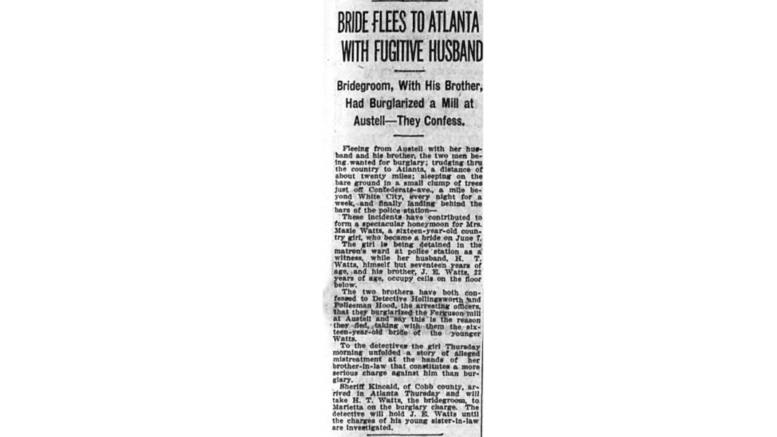By Larry Felton Johnson
I’m going to do this introduction in first-person, because I want to make a personal observation about the story I’ve reprinted below.
There are references in this 1911 article from the Atlanta Georgian to Confederate Avenue (now United Avenue) and White City.
The article is about a newly married couple fleeing Austell after the groom, along with his brother, burglarized a mill in Austell.
I grew up in the 1950s in the area where the couple and the groom’s brother fled after the young men burglarized Austell’s Ferguson Mill.
White City was an amusement park owned by Charles Chosewood, who lived on Waldo Street at the corner of Confederate Ave, adjacent to the park and about a half block from Grant Park.
Even when my late mother was a child, the park had gone out of business (she was born in 1921), but in the 1950s and early 1960s, I played in the park’s ruins, which at that point consisted of overgrown hedge mazes and the swampy remains of a lake.
Now, an elementary school is on the site.
The place the fugitives slept would have been near the corner of modern-day United Avenue and Moreland Avenue.
Here’s a copy of the article, followed by an image of how it looked in the original 1911 newspaper.
BRIDE FLEES TO ATLANTA WITH FUGITIVE HUSBAND
A bridegroom and his brother, wanted for burglarizing a mill in Austell, have confessed to their crime.
Fleeing from Austell with her husband and his brother, trudging through the countryside to Atlanta, a distance of about twenty miles, and sleeping on the bare ground in a small clump of trees just off Confederate Avenue, a mile beyond White City, every night for a week, And finally winding up behind the bars of the police station
These incidents have contributed to form a spectacular honeymoon for Mrs. Masie Watts, a sixteen-year-old country girl who became a bride on June 7.
The girl is being detained in the matron’s ward at the police station as a witness, while her husband, H. T. Watts, who is seventeen years old, and his brother, J. E. Watts, 22 years old, occupy cells on the floor below. The two brothers have both confessed to Detective Hollingsworth and Policeman Hood, the arresting officers, that they burglarized the Ferguson Mill at Austell and claimed this as the reason for their flight, taking with them the sixteen-year-old bride of the younger Watts.
To the detectives on Thursday morning, the girl unfolded a story of alleged mistreatment at the hands of her brother-in-law, which constitutes a more serious charge against him than burglary.
Sheriff Kincaid of Cobb County arrived in Atlanta on Thursday and will take H. T. Watts, the bridegroom, to Marietta on the burglary charge. The detectives will hold J. E. Watts until the charges made by his young sister-in-law are investigated.

About Georgia Historic Newspapers
Georgia Historic Newspapers is part of the GALILEO project and is housed at the University of Georgia. It’s an amazing resource for anyone interested in the history of Georgia and its regions.
According to the “About” page on its website:
The Georgia Historic Newspapers Archive is a project of the Digital Library of Georgia (DLG), a part of Georgia’s Virtual Library GALILEO and is based at the University of Georgia Libraries. Since 2007, the DLG has partnered with universities, archives, public libraries, historical societies, museums, and other cultural heritage institutions to digitize historical newspapers from around the state. The archive is free and open for public use and includes over two million Georgia newspaper pages between 1763 and 2021.
Newspaper titles are regularly digitized and added to the archive. If you are interested in including a particular title, you can visit our participation page. A majority of the newspapers on this site were digitized from the microfilm produced by the Georgia Newspaper Project (GNP). For more information about the microfilm available through the GNP, please visit their website.
